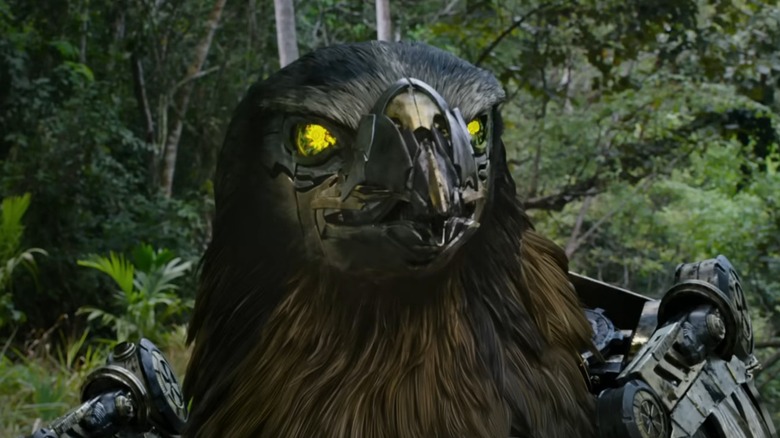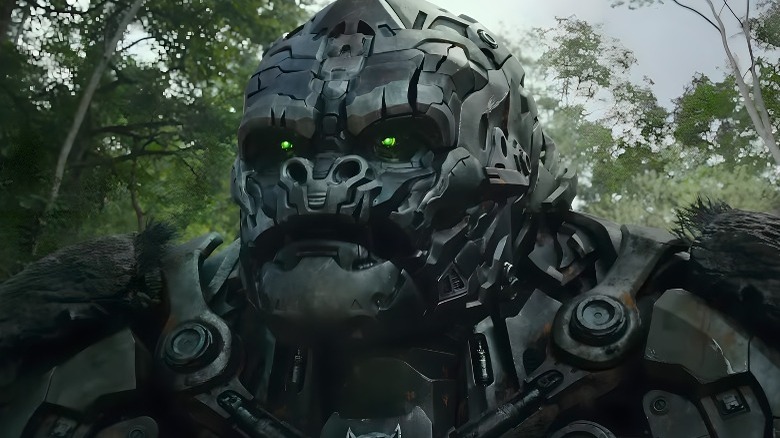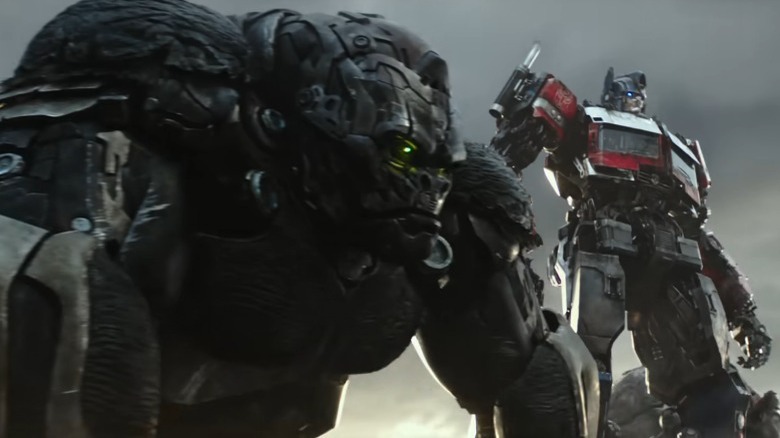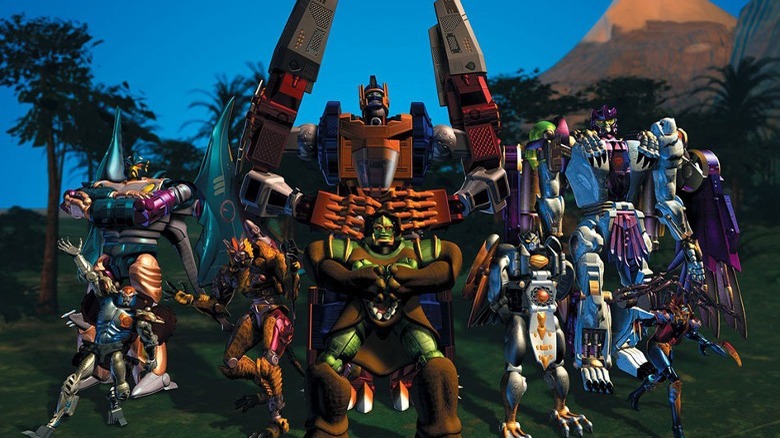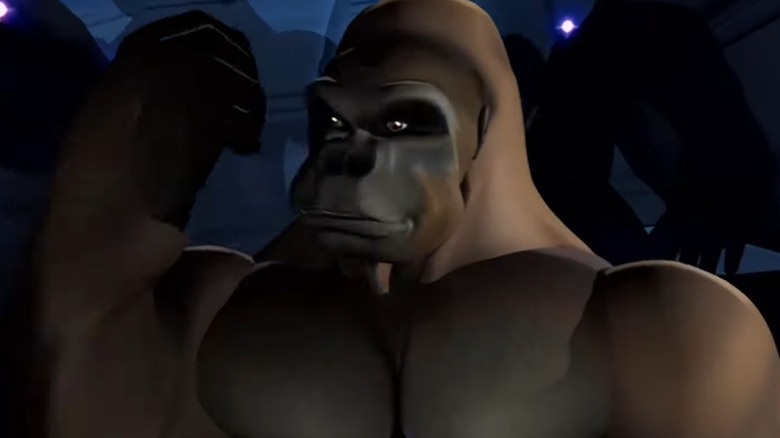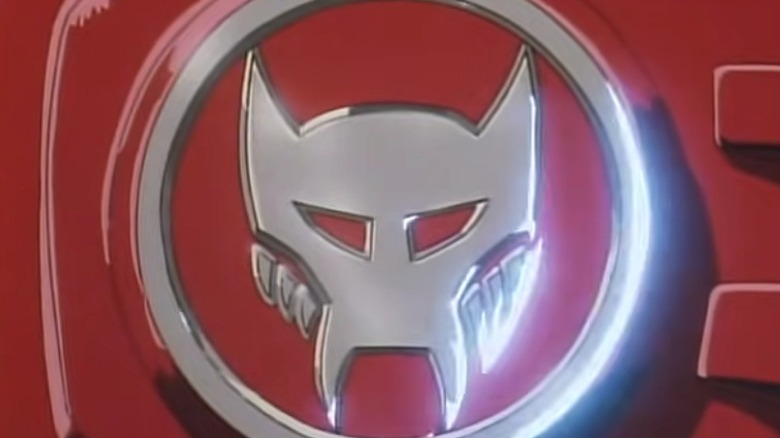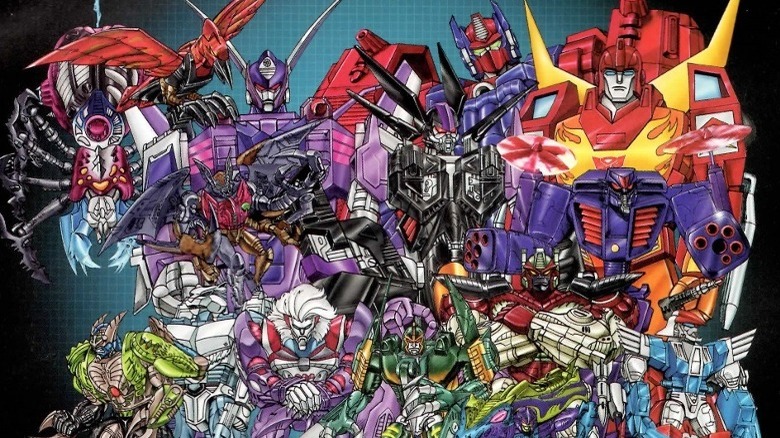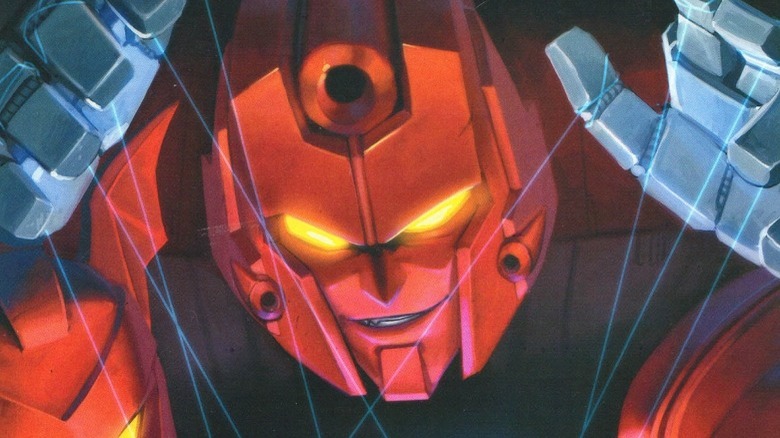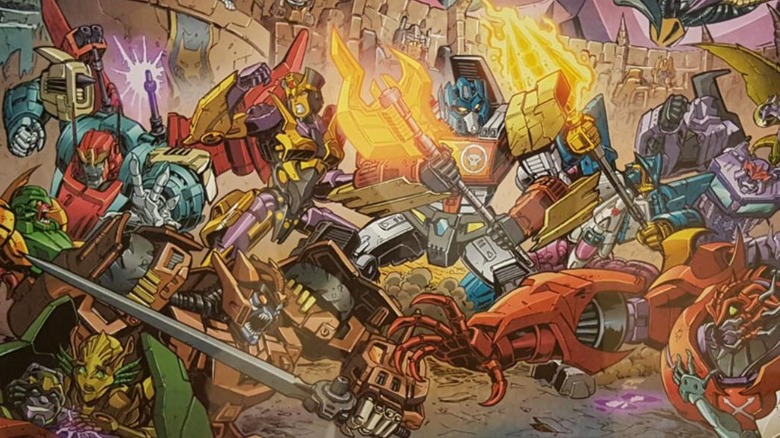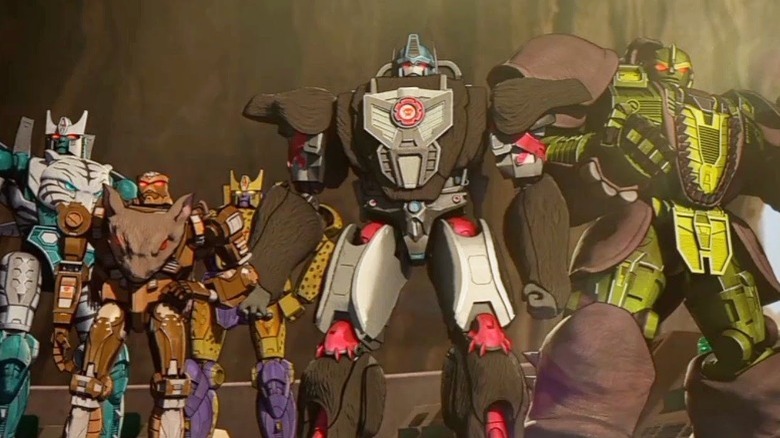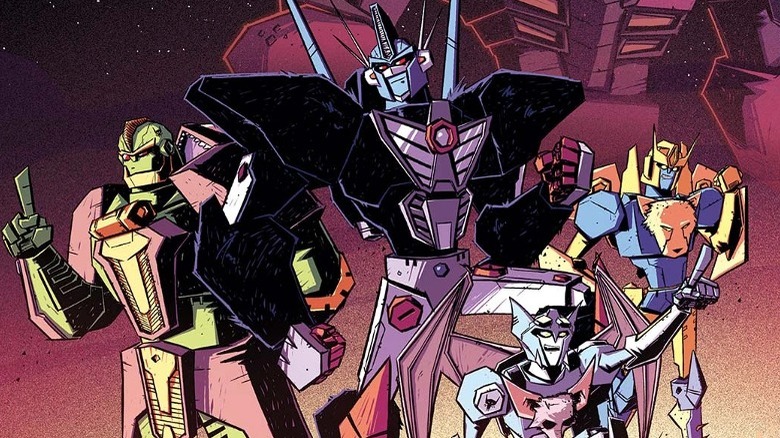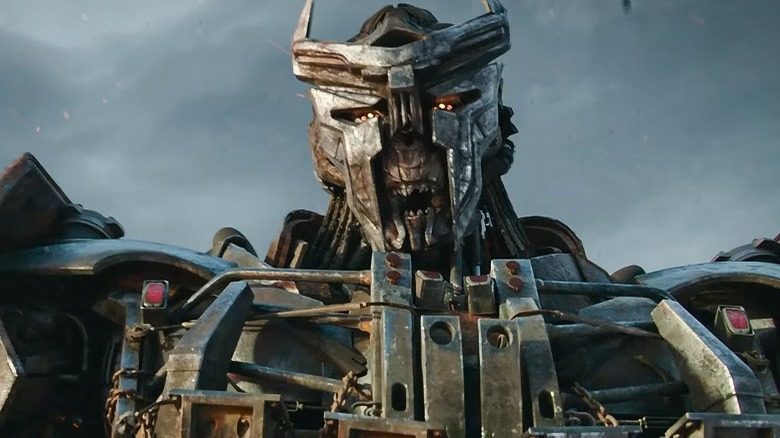The Complete History Behind Transformers' Maximals Explained
By now almost everyone is familiar with the "Transformers" formula. There are plenty of things that happen in every "Transformers" movie, and most of the key characters show up over and over again. The Autobots are the good robots, eternally battling against evil robots called the Decepticons, and one way or another humanity itself always gets stuck in the crossfire. It's a tale as old as the "Transformers" franchise itself.
There's a heap of new Transformers coming to the latest film, "Rise of the Beasts." Diehard fans have an extra reason to get excited about the film, because the Maximals are finally becoming movie stars. They've been around since the late '90s, when the "Beast Wars" TV show first introduced the world to robots that could take the shape of animals. On TV and in comic books, the Maximals have fought a slew of wars since then, and they've developed a convoluted history that's constantly shifting thanks to recons, reboots, and a healthy dose of time travel.
The Maximals don't always get to work side-by-side with the Autobots, and they rarely get a chance to interact with human beings. The new "Transformers" film is poised to transform their story in a big way, but if you're looking to get your head around everything you need to know about "Rise of the Beasts," you should start by understanding the entire history of the Maximals joining the franchise.
Maximals and the Great War
Anyone who's even slightly familiar with the "Transformers" franchise knows that it usually follows an ongoing battle between two groups of robots. The Autobots and the Decepticons have been at war for as long as the series has existed. Technically, the two groups have fought multiple wars over centuries, if not millennia, but the Great War was the most consequential, and it's where the Maximals enter the scene.
There have been a number of different series about the Maximals that all establish their own chronologies. Like any story that gets told in a comic book format, the history of the Maximals has changed over the years, but there are some details that remain generally the same across the various continuities.
The Maximals themselves didn't fight in the Great War. In the "Beast Wars" cartoon that originally set up the characters, the Maximals didn't come into existence until the war had ended, and their superior technology eventually led to them replacing the Autobots and Decepticons. In the IDW comic "Dawn of the Predacus," the Maximals were actually present for the end of the Great War, but they didn't start getting involved in the regular conflicts of Cybertron until it was finished. Either war, the age of the Maximals comes well after the Autobots and Decepticons have finished their fighting, but in most versions of the story, that still means the Maximals predate humanity by thousands of years.
What was the Great Upgrade?
The Maximals are the descendants of the Autobots. They inherit Cybertron after the end of the Great War, but obviously evolution on the machine world doesn't work quite the same way it does here on Earth. The Maximals didn't evolve from their predecessors over a stretch of millennia — instead, they're created more-or-less instantly in a process called the Great Upgrade.
Like the Great War, and almost every other aspect of "Transformers" continuity, the finer details of the Great Upgrade change from one story to another, but the broad strokes of the process remain the same. The Great Upgrade created some serious changes to Transformer biology, if it can be called biology. Compared to the Autobots, the Maximals are much smaller, and they require less energy to function. They also, of course, have the ability to scan biological material and change their shape to match whatever creature they've scanned.
The Great Upgrade isn't just the process that turned the Autobots into the Maximals. It also refers to the process that changed Cybertron itself. Unlike planets with organic life, Cybertron can easily be modified by its inhabitants to better suit their needs. The Maximals changed Cybertron to match their new energy efficient bodies, and they also restructured Transformer society to be more stable and peace-focused in the wake of the Great War. Unfortunately, the Autobots weren't the only ones who got upgraded. The Decepticons became the Predacons, and a new conflict began to brew.
The original Beast Wars
Most "Transformers" fans first met the Maximals in the 1996 cartoon "Beast Wars: Transformers." The cartoon dramatically altered the Transformers that fans had come to know and love, and it told the story of the Maximals with a brand new animation style. The show actually won a Daytime Emmy for Outstanding Achievement in Animation, and though it might be a bit dated today, it's still one of the best "Transformers" shows of all time.
"Beast Wars" introduces new characters who are largely based on their Transformer ancestors. The leader of the Maximals, for example, is Optimus Primal, while the leader of the Predacons holds onto the name Megatron from his Decepticon counterpart. The show opens hundreds of years after the Great War, and during all that time Cybertron existed mostly in peace. Now the Predacons and Maximals are back at war, and in Episode 1 Optimus Primal and Megatron are piloting ships through deep space when they crash land on an unknown planet.
That planet turns out to be prehistoric Earth, which gives the Maximals and Predacons plenty of options for their animal transformations. War breaks out between the two groups and threatens to ruin Earth before humanity ever gets a chance to inhabit the planet. Luckily the Maximals end up being victorious, and they get to make their way back to Cybertron with new technology that has the potential to bring their Autobot ancestors back to life.
Time travel creates some problems
The Maximals have access to all kinds of technology that the Autobots could only dream of. The most prominent technology is part of their bodies. It allows them to harness Energon at peak proficiency, scan lifeforms, and transform into organic creatures. Other bits of advanced tech are attached to the ships that Maximals use to travel throughout the galaxy at warp speed. As is often the case in sci-fi stories, though, warping through the universe can occasionally create more problems than it solves.
"Beast Machines" was a 1999 cartoon that ran for 26 episodes over the course of 2 seasons. It picked up right where the "Beast Wars" cartoon left off, but it offered a brand new twist on Transformer-based conflicts. Namely, it brought time travel to the "Transformers" franchise in a big way.
At the beginning of the show, the Maximals are traveling back to Cybertron with the Predacon leader Megatron held in captivity. That's when their ship's pesky warp drive acts up and opens a sort of rift through time that allows Megatron to not only escape but also reach Cybertron well ahead of the Maximals. Megatron uses his lead time to completely take over the planet, and suddenly the centuries of peace that Cybertron had enjoyed are completely shattered. Luckily the Maximals once again manage to defeat their enemies and restore peace on their home planet.
Maximals arrived on post-apocalyptic Earth
The "Beast Wars" cartoon had another sequel called "Beast Wars II: Super Life-Form Transformers," but that title is actually a little misleading. Unlike "Beast Machines," "Beast Wars II" isn't really a direct sequel to the original cartoon. Instead, it's set far in the future and follows a largely new cast of Maximal characters going up against evil Predacons led by the villain Galvatron.
Like the original "Beast Wars," this sequel cartoon sees the Maximals and Predacons mostly fighting each other on the planet Earth. This time around, though, the conflict is set tens of thousands of years in the future. Earth is now referred to as Gaia, and humanity has long since collapsed. Amidst the post-apocalyptic ruins, the Maximals and Predacons battle it out, but the biggest threat to the Maximals comes from deep space.
Galvatron's plan involves bringing an artificial planet called Nemesis to Gaia. The constructed planet will absorb all of Gaia's life force, and then it will be powerful enough to give Galvatron control over the entire universe. The cartoon was popular enough to get another sequel, called "Beast Wars Neo," but even though the shows aired at roughly the same time as "Beast Machines," the two storylines didn't overlap.
The 3H era
The Maximals began their story in the "Beast Wars" cartoon, but eventually they became popular enough to start showing up in comic books just like the Autobots and Decepticons. 3H comics handled many of the earliest stories about the Maximals, and initially those comics retread much of the same ground that the "Beast Wars" show had already covered.
The story "Disclosure" really pushed the Maximals into new territory and continued roughly from where the "Beast Machines" cartoon had ended. In "Disclosure" and the stories that followed, the Maximals find themselves up against a new enemy even more dangerous than Megatron and the Predacons. The Quintessons are an ancient, extraterrestrial race with unimaginable power. Unfortunately, instead of using their power for good, the Quintessons set their sights on invading and taking over Cybertron.
This new battle comes to a dramatic conclusion in a story called "Wreckers: Finale Part 2." Saving Cybertron from the Quintessons requires something almost entirely new for the "Transformers" series: cooperation between the Maximals and the Predacons. Luckily, both groups are able to see past their differences and work together to defeat their alien enemies, and the story ends with Cybertron back under the control of the Transformers.
The IDW era
The first era of the Maximal continuity was dominated by the "Beast Wars" cartoon and the 3H comic books. In 2006 comic book publisher IDW took over the franchise, and the history of the Maximals was rewritten. The main elements of the characters stayed the same from one continuity to the next, but the way that their story unfolded was very different.
The IDW story "Dawn of the Predacus" explains how the Maximals and Predacons came into being. In this version of the story, some Maximals and Predacons exist at the same time as the Autobots and Decepticons. They're present in the final days of the Great War, and they witness Optimus Prime and Galvatron both die in battle. When the war ends, the Maximals and Predacons slowly take over Cybertron, and eventually the Great Upgrade transitions them into fuel efficient bodies and officially puts an end to the era of Autobots and Decepticons.
As Cybertron ends a lengthy time of peace, the Maximals begin focusing on exploring the universe around them, just like they were shown doing at the beginning of the "Beast Wars" cartoon. The story comes full circle when Megatron again uses time travel to get the upper hand on the Maximals in the comic story "Dawn of Future's Past."
Beast Wars: Uprising
We aren't done rewriting Maximal history quite yet. There's another lengthy comic book story that provides a fresh take on the Maximals and the entire "Beast Wars" saga. It's called "Beast Wars: Uprising," and it breaks from the previously established canon in a number of ways.
"Uprising" is essentially an alternate universe story set in a dystopian version of Cybertron (assuming that the regular, constantly war-torn Cybertron isn't already a dystopia). In this universe, humanity survived some Transformer-related conflicts and made its way out into the stars. The Human Confederacy has become the dominant government in the universe, and it's subjugated the Autobots and Decepticons, forcing them to remain on Cybertron forever.
The two Transformer factions have finally settled their constant fighting. Together they create the Maximals and Predacons, intending to use these new types of machines to maintain order on Cybertron and to secure their place as the leaders of the planet. A Maximal called Lio Convoy has his own ideas about how Cybertron should function, and he gathers forces to lead a rebellion against the Autobots, Decepticons, and any of their loyal creations. It's a whole new take on transforming robots battling each other, but in many ways it's exactly the same kind of story that "Transformers" fans have always loved.
War for Cybertron
One of the most recent "Transformers" projects to explore what's going on with the Maximals is the "War for Cybertron Trilogy." The animated series, which made its way to Netflix in 2018, is based on a new line of "Transformers" toys and features some of the most intense battles between the Autobots and Decepticons to date.
In the series, the classic two Transformer factions are once again battling for dominance over Cybertron. This isn't the Great War that we've previously discussed, however. Instead, this epic battle ends up roping in the Maximals when the Autobots and Decepticons accidentally travel through time. They land on the prehistoric Earth, where the Maximals and Predacons have already begun fighting each other.
Naturally, the four factions end up pairing off and creating all-new super armies. The Autobots and Maximals decide that it's their duty to try and stop the combined forces of the Decepticons and Predacons. As more timelines converge, they end up facing Galvatron — a future version of Megatron — and a mad version of Optimus Prime from a distant future. Eventually the four main factions agree to a ceasefire, and Cybertron once again enters an age of peace. By this time, we all know it won't last long.
The new Beast Wars
In nerdy fandoms, particularly ones heavily involved in comic books, reboots and retcons are a given. In the first two decades that they existed, the Maximals had a number of different stories told about their origin and their war with the Predacons. In 2021, IDW decided to reboot the tale again with a new "Beast Wars" comic series that began with the story "Savage Landing."
Once again time travel ends up becoming a part of the story, and once again the Maximals and Predacons are forced to set aside their animosity and unite their forces to fight an even stronger foe. This time the existential threat is a race of aliens called the Vok that exist as forms of strange energy. In "Beast Wars: The End," the Transformers all realize that the only way to avoid being absolutely destroyed by the Vok is to work together.
Megatron refuses to accept that he must work with the Maximals, and he continues fighting despite the threat posed by the Vok. He ends up being destroyed in battle, and after the Vok are defeated the Maximals return to Cybertron while the Predacons decide to forge their own path through the universe. In a surprise cliffhanger, "The End" reveals Megatron's resurrection and the beginning of his new plan to strike the Maximals down once and for all.
Rise of the Beasts
After nearly three decades of animated TV shows, toys, and comic books, the Maximals have finally made their way to the big screen. "Rise of the Beasts" introduces some fan-favorite Maximals, including Optimus Primal, to the cinematic universe, but it also makes some dramatic changes to their backstory.
In this version of events the Maximals lived on a planet colonized by Transformers millennia before the Earth was populated by human beings. After being attacked by Unicron, the Maximals made their way to prehistoric Earth, where they could hide themselves and their powerful technology from their enemies. They found some peace on Earth, but it wasn't meant to last.
In the mid-'90s, the conflict between Unicron and the Maximals resurges, but this time the Autobots are ready to step in and help save the day. Rather than adapting a story from the "Beast Wars" cartoon, "Rise of the Beasts" has the Autobots and Maximals fight a faction of Transformers called the Terrorcons, who all work on behalf of Unicron. The story lets some big name characters get a chance to shine while still leaving the door open for some of the most popular Maximal storylines to be adapted in the future.
